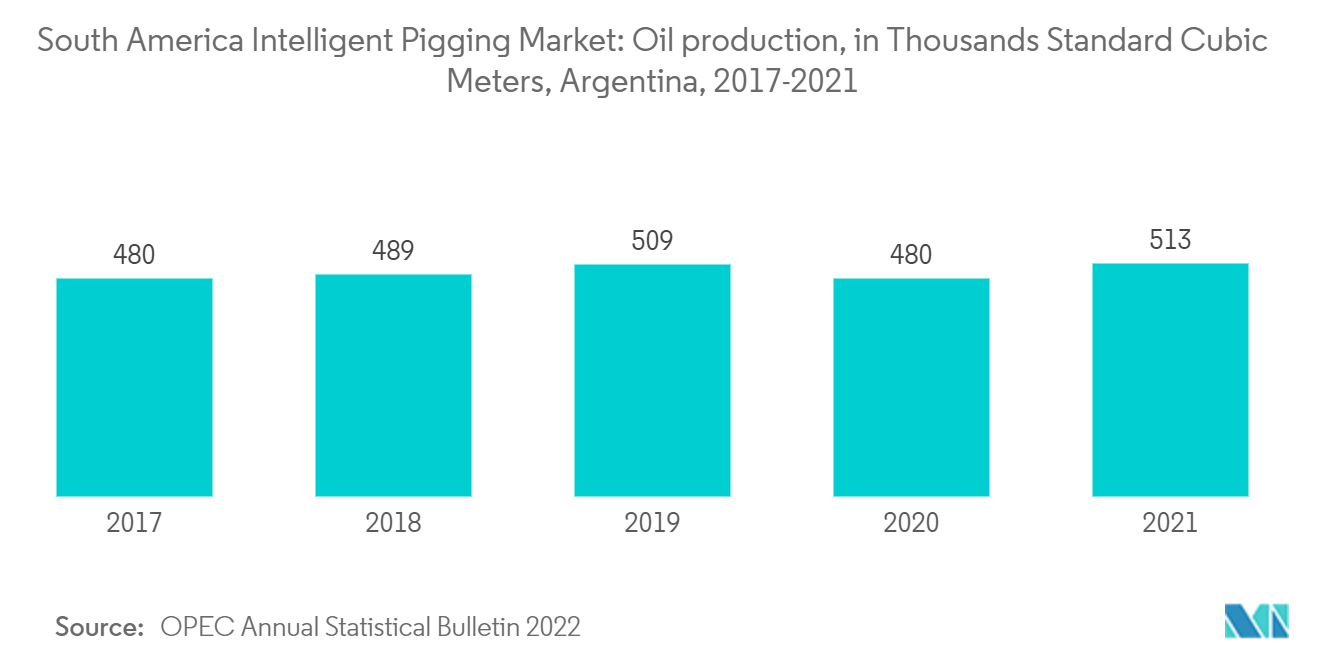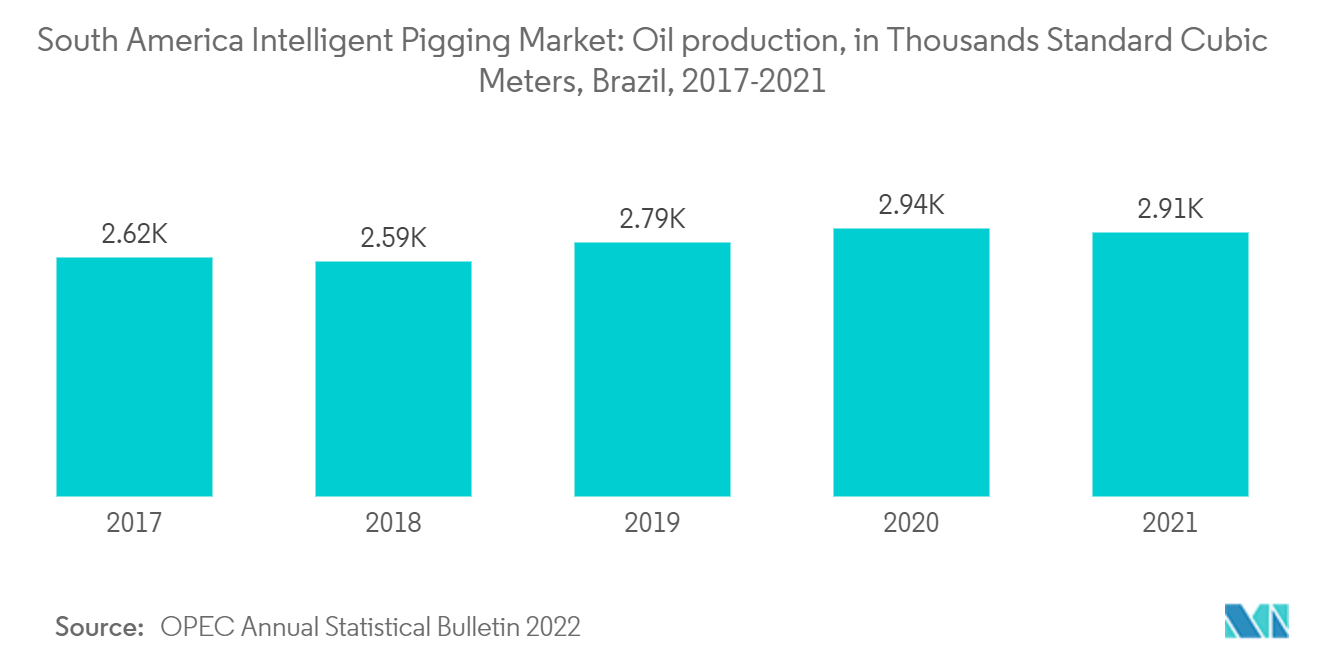Market Trends of South America Intelligent Pigging Industry
Oil Segment Expected to Witness Significant Growth
- Pipelines are safe and efficient for conveying high-value commodities like crude oil. However, they are vulnerable to corrosion and deposits, which reduce flow rates and cause expensive failures. Cleaning pigs remove residues and ensure pipeline integrity, and then intelligent pigging detects defects. Intelligent pigging solutions regularly monitor the pipeline for defect growth, minimizing costs and reducing risks in regular operations.
- Intelligent pigging helps detect wax, sand, bacterial formations, chemical residues, scale, rust, and other impurities in crude oil pipelines. Oil pipelines are made from steel conduits which are usually buried. The crude oil is driven through the pipelines by pump stations along the pipeline. Crude oil pipelines are the most familiar, safest, and most affordable of all methods of crude oil and refined product carrier of transporting materials compared to road or rail. Pipeline networks are built to transport crude oil from nearby oil wells to oil tankers long distances.
- Pipelines dominate the oil transportation industry. The crude oil supply in different regions is expected to exceed the existing transportation capacity, requiring expansions and the construction of new pipelines.
- During the forecast period, Argentina is expected to play a vital role in the region's oil & gas midstream market growth. The country is home to one of the most significant shale formations in the world, Vaca Muerta, which represents excellent potential for the midstream market.
- Oil production in Argentina amounted to 513 thousand barrels per day in 2021, an increase of 33 barrels daily compared to the previous year. Furthermore, crude oil reserves in Argentina amounted to 2.48 billion barrels in 2021, up from 2.39 billion barrels in the last year. Argentina has the fifth largest crude oil reserves in South America.
- Argentina's state-owned oil company YPF's CAPEX in 2021 stood at around USD 2.71 billion, representing an increase of almost 74% when compared to the value in 2020 (CAPEX in 2020: USD 1.55 billion); the company is planning to further increase the CAPEX in the country's oil & gas sector, especially in the midstream activities during the forecast period.
- For instance, in September 2022, YPF announced plans to invest about USD1.26 billion to construct a 435-mile pipeline from the Vaca Muerta unconventional deposit to a new crude oil export terminal built in the Rio Negro region in southern Argentina. The construction is expected to commence in March 2023. The pipeline is anticipated to carry 60,000 cubic meters of crude oil or about 372,000 barrels per day. The infrastructure is scheduled for completion by 2025.
- Hence, owing to the above points, the oil segment is likely to see significant growth in the market during the forecast period.

Brazil Expected to see Significant the Market Growth
- Brazil accounts for about 2.9 million barrels per day of crude oil production and was the tenth-largest oil-producing country in the world in 2021. According to the United States Energy Information Administration (EIA), over 90% of Brazil's oil production is extracted from offshore deep-water oil fields. According to EIA, Brazil had 12.7 billion barrels of proven crude reserves in 2021, the second largest in South America after Venezuela.
- Around 30 offshore oil & gas projects are expected to start across the region by 2023, which requires a cumulative greenfield investment of around USD 50 billion. These projects are operated by a mix of National Oil Companies (NOCs) and major independent companies.
- As of 2021, Brazil was the major country in South America regarding oil and gas spending. The country's offshore pre-salt oil fields pumped around 50% of the total oil output, and this share increased to approximately 75% by the end of 2020. This increasing production and dependency on offshore oil & gas fields can be attributed to steadily decreasing production expenses due to improved drilling technology, growing expertise in the offshore oil & gas industry, and increased infrastructure.
- The increasing investments from Petrobras and foreign oil companies are expected to drive the oil and gas sector in the country, in turn driving the demand for intelligent pigging during the forecast period. Brazil has several large-scale offshore upstream projects in the pipeline, and it is expected to contribute more than 20% of global offshore crude oil and condensate production by 2025. Most of the production is expected from the Pao de Acucar in the Campos basin and Carcara fields, initiated by 2022. With the commencement of production from these two fields, the demand for intelligent pigging in the upstream and midstream industries is expected to increase significantly, driving the intelligent pigging market during the forecast period.
- Petrobras, the country's national oil company, has an extensive natural gas pipeline network of around 9000 km. Apart from the existing pipeline, 11 gas pipeline projects have been announced or outlined by companies operating in the country in recent years. The announced projects make up over 1900 km of new pipelines in pipeline extensions, offshore pipelines, etc. In August 2021, Brazil started negotiations with Argentina to construct a 1430 km long pipeline exporting gas from Vaca Muerta reserves at an estimated cost of nearly USD 4.9 billion. Such projects are expected to provide an opportunity for the intelligent pigging market in the country's midstream oil and gas sector.
- Hence, owing to the above points, Brazil is expected to see significant market growth in the Intelligent pigging market during the forecast period.


